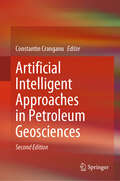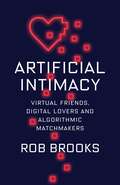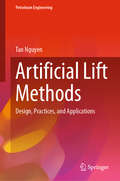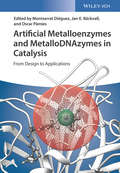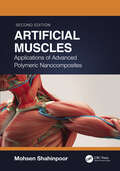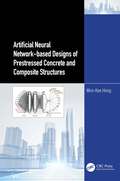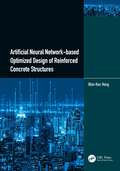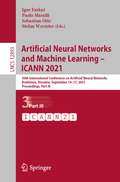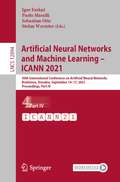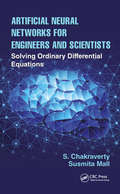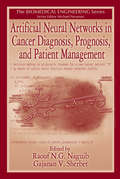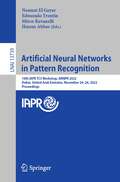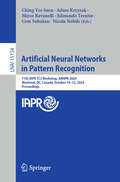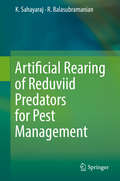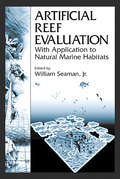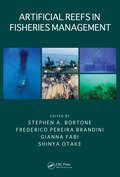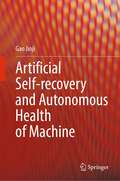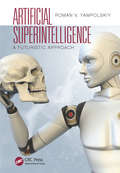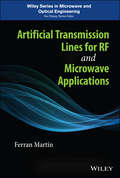- Table View
- List View
Artificial Intelligent Approaches in Petroleum Geosciences
by Constantin Cranganu Henri Luchian Mihaela Elena BreabanThis book presents several intelligent approaches for tackling and solving challenging practical problems facing those in the petroleum geosciences and petroleum industry. Written by experienced academics, this book offers state-of-the-art working examples and provides the reader with exposure to the latest developments in the field of intelligent methods applied to oil and gas research, exploration and production. It also analyzes the strengths and weaknesses of each method presented using benchmarking, whilst also emphasizing essential parameters such as robustness, accuracy, speed of convergence, computer time, overlearning and the role of normalization. The intelligent approaches presented include artificial neural networks, fuzzy logic, active learning method, genetic algorithms and support vector machines, amongst others. Integration, handling data of immense size and uncertainty, and dealing with risk management are among crucial issues in petroleum geosciences. The problems we have to solve in this domain are becoming too complex to rely on a single discipline for effective solutions and the costs associated with poor predictions (e. g. dry holes) increase. Therefore, there is a need to establish a new approach aimed at proper integration of disciplines (such as petroleum engineering, geology, geophysics and geochemistry), data fusion, risk reduction and uncertainty management. These intelligent techniques can be used for uncertainty analysis, risk assessment, data fusion and mining, data analysis and interpretation, and knowledge discovery, from diverse data such as 3-D seismic, geological data, well logging, and production data. This book is intended for petroleum scientists, data miners, data scientists and professionals and post-graduate students involved in petroleum industry.
Artificial Intelligent Approaches in Petroleum Geosciences
by Constantin CranganuThis book presents cutting-edge approaches to solving practical problems faced by professionals in the petroleum industry and geosciences. With various state-of-the-art working examples from experienced academics, the book offers an exposure to the latest developments in intelligent methods for oil and gas research, exploration, and production. This second edition is updated with new chapters on machine learning approaches, data-driven modelling techniques, and neural networks. The book delves into machine learning approaches, including evolutionary algorithms, swarm intelligence, fuzzy logic, deep artificial neural networks, KNN, decision tree, random forest, XGBoost, and LightGBM. it also analyzes the strengths and weaknesses of each method and emphasizes essential parameters like robustness, accuracy, speed of convergence, computer time, overlearning, and normalization. Integration, data handling, risk management, and uncertainty management are all crucial issues in petroleum geosciences. The complexities of these problems require a multidisciplinary approach that fuses petroleum engineering, geology, geophysics, and geochemistry. Essentially, this book presents an approach for integrating various disciplines such as data fusion, risk reduction, and uncertainty management. Whether you are a professional or a student, you can greatly benefit from the latest advancements in intelligent methods applied to oil and gas research. This comprehensive and updated book presents cutting-edge approaches and real-world examples that can help you in solving the intricate challenges of the petroleum industry and geosciences.
Artificial Intimacy: Virtual Friends, Digital Lovers, and Algorithmic Matchmakers
by Rob BrooksWhat happens when the human brain, which evolved over eons, collides with twenty-first-century technology? Machines can now push psychological buttons, stimulating and sometimes exploiting the ways people make friends, gossip with neighbors, and grow intimate with lovers. Sex robots present the humanoid face of this technological revolution—yet although it is easy to gawk at their uncanniness, more familiar technologies based in artificial intelligence and virtual reality are insinuating themselves into human interactions. Digital lovers, virtual friends, and algorithmic matchmakers help us manage our feelings in a world of cognitive overload. Will these machines, fueled by masses of user data and powered by algorithms that learn all the time, transform the quality of human life?Artificial Intimacy offers an innovative perspective on the possibilities of the present and near future. The evolutionary biologist Rob Brooks explores the latest research on intimacy and desire to consider the interaction of new technologies and fundamental human behaviors. He details how existing artificial intelligences can already learn and exploit human social needs—and are getting better at what they do. Brooks combines an understanding of core human traits from evolutionary biology with analysis of how cultural, economic, and technological contexts shape the ways people express them. Beyond the technology, he asks what the implications of artificial intimacy will be for how we understand ourselves.
Artificial Life: How to Create a Life Computationally (Intelligent Systems Reference Library #262)
by Seiki AkamaThis book provides some resources of Artificial Life. Artificial Life (ALife or A-Life) is the research area which simulates a life computationally. It involves several approaches to living systems in artificial manners. It was recognized as a scientific field in the 1980's. Artificial Life is related to many scientific fields including biology and computer science, and its history is old. In fact, the earlier works have been done by people like Turing and von Neumann. Fields like that neural networks, evolutionary computation, and cellular automaton constitute the foundations for Artificial Life. The so-called wet ware is an approach in more biology-oriented, which is known that there are some Artificial Life Systems at present. It is expected to see further progresses of this exciting field. The materials include: history, philosophy, related areas, recent developments, etc. Starting from the overview, the authors give an exposition of basic subjects like cellular automaton, neural networks, evolutionary computation, and wet ware. The authors also introduce some examples of Artificial Life Systems like Boids, Tierra, and Open Warm. The book is intended for those, like experts and students, who wish to get involved in the field as a monograph or a textbook for the subject. It is also useful for beginners. But, the authors assume that the reader has mastered the material ordinarily covered in AI and mathematics.
Artificial Lift Methods: Design, Practices, and Applications (Petroleum Engineering)
by Tan NguyenThis book details the major artificial lift methods that can be applied to hydrocarbon reservoirs with declining pressure. These include: the sucker rod pump, gas lift, electrical submersible pump, progressive cavity pump, and plunger lift. The design and applications, as well as troubleshooting, are discussed for each method, and examples, exercises and design projects are provided in order to support the concepts discussed in each chapter. The problems associated with oil recovery in horizontal wells are also explored, and the author proposes solutions to address the various extraction challenges that these wells present. The book represents a timely response to the difficulties associated with unconventional oil sources and declining wells, offering a valuable resource for students of petroleum engineering, as well as hydrocarbon recovery researchers and practicing engineers in the petroleum industry.
Artificial Materials (Wiley-iste Ser.)
by Olivier VanbésienThis book addresses artificial materials including photonic crystals (PC) and metamaterials (MM). The first part is devoted to design concepts: negative permeability and permittivity for negative refraction, periodic structures, transformation optics. The second part concerns PC and MM in stop band regime: from cavities, guides to high impedance surfaces. Abnormal refraction, less than one and negative, in PC and MM are studied in a third part, addressing super-focusing and cloaking. Applications for telecommunications, lasers and imaging systems are also explored.
Artificial Metalloenzymes and MetalloDNAzymes in Catalysis: From Design to Applications
by Montserrat Diéguez Jan-E. Bäckvall Oscar PàmiesAn important reference for researchers in the field of metal-enzyme hybrid catalysis Artificial Metalloenzymes and MetalloDNAzymes in Catalysis offers a comprehensive review of the most current strategies, developed over recent decades, for the design, synthesis, and optimization of these hybrid catalysts as well as material about their application. The contributors—noted experts in the field—present information on the preparation, characterization, and optimization of artificial metalloenzymes in a timely and authoritative manner. The authors present a thorough examination of this interesting new platform for catalysis that combines the excellent selective recognition/binding properties of enzymes with transition metal catalysts. The text includes information on the various applications of metal-enzyme hybrid catalysts for novel reactions, offers insights into the latest advances in the field, and contains an informative perspective on the future: Explores the development of artificial metalloenzymes, the modern and strongly evolving research field on the verge of industrial application Contains a comprehensive reference to the research area of metal-enzyme hybrid catalysis that has experienced tremendous growth in recent years Includes contributions from leading researchers in the field Shows how this new catalysis combines the selective recognition/binding properties of enzymes with transition metal catalysts Written for catalytic chemists, bioinorganic chemists, biochemists, and organic chemists, Artificial Metalloenzymes and MetalloDNAzymes in Catalysis offers a unique reference to the fundamentals, concepts, applications, and the most recent developments for more efficient and sustainable synthesis.
Artificial Muscles: Applications of Advanced Polymeric Nanocomposites
by Mohsen ShahinpoorSmart materials are the way of the future in a variety of fields, from biomedical engineering and chemistry to nanoscience, nanotechnology, and robotics. Featuring an interdisciplinary approach to smart materials and structures, this second edition of Artificial Muscles: Applications of Advanced Polymeric Nanocomposites has been fully updated to thoroughly review the latest knowledge of ionic polymeric conductor nanocomposites (IPCNCs), including ionic polymeric metal nanocomposites (IPMNCs) as biomimetic distributed nanosensors, nanoactuators, nanotransducers, nanorobots, artificial muscles, and electrically controllable intelligent polymeric network structures. Authored by one of the founding fathers of the field, the book introduces fabrication and manufacturing methods of several electrically and chemically active ionic polymeric sensors, actuators, and artificial muscles, as well as a new class of electrically active polymeric nanocomposites and artificial muscles. It also describes a few apparatuses for modeling and testing various artificial muscles to show the viability of chemoactive and electroactive muscles. It presents the theories, modeling, and numerical simulations of ionic polymeric artificial muscles’ electrodynamics and chemodynamics and features current industrial and medical applications of IPMNCs. By covering the fabrication techniques of and novel developments in advanced polymeric nanocomposites, this second edition continues to provides an accessible yet solid foundation to the subject while stimulating further research. Key features: Fully up to date with the latest cutting-edge discoveries in the field Authored by a world expert in the subject area Explores the exciting and growing topic of smart materials in medicine Mohsen Shahinpoor is Professor of Mechanical Engineering at the University of Maine and a leading expert in artificial muscles.
Artificial Neural Network-based Designs of Prestressed Concrete and Composite Structures
by Won‐Kee HongThis book introduces artificial neural network (ANN)-based Lagrange optimization techniques for a structural design of prestressed concrete structures based on Eurocode 2, and composite structures based on American Institute of Steel Construction and American Concrete Institute standards. The book provides robust design charts for prestressed concrete structures, which are challenging to achieve using conventional design methods.Using ANN-based design charts, the holistic design of a post-tensioned beam is performed to optimize design targets (objective functions), while calculating 21 forward outputs, in arbitrary sequences, from 21 forward inputs. Applies the powerful tools of ANN to the optimization of prestressed concrete structures and composite structures including columns and beams Multi-objective optimizations (MOO) of prestressed concrete beams are performed using an ANN-based Lagrange algorithm Offers a Pareto frontier using an ANN-based MOO for composite beams and composite columns sustaining multi-biaxial loads Heavily illustrated in color and with diverse practical design examples in line with EC2, ACI, and ASTM codes The book offers optimal solutions for structural designers and researchers, enabling readers to construct design charts to minimize their own design targets under various design requirements based on any design code.
Artificial Neural Network-based Optimized Design of Reinforced Concrete Structures
by Won‐Kee HongArtificial Neural Network-based Optimized Design of Reinforced Concrete Structures introduces AI-based Lagrange optimization techniques that can enable more rational engineering decisions for concrete structures while conforming to codes of practice. It shows how objective functions including cost, CO2 emissions, and structural weight of concrete structures are optimized either separately or simultaneously while satisfying constraining design conditions using an ANN-based Lagrange algorithm. Any design target can be adopted as an objective function. Many optimized design examples are verified by both conventional structural calculations and big datasets. Uniquely applies the new powerful tools of AI to concrete structural design and optimization Multi-objective functions of concrete structures optimized either separately or simultaneously Design requirements imposed by codes are automatically satisfied by constraining conditions Heavily illustrated in color with practical design examples The book suits undergraduate and graduate students who have an understanding of collegelevel calculus and will be especially beneficial to engineers and contractors who seek to optimize concrete structures.
Artificial Neural Networks and Machine Learning – ICANN 2021: 30th International Conference on Artificial Neural Networks, Bratislava, Slovakia, September 14–17, 2021, Proceedings, Part III (Lecture Notes in Computer Science #12893)
by Paolo Masulli Stefan Wermter Igor Farkaš Sebastian OtteThe proceedings set LNCS 12891, LNCS 12892, LNCS 12893, LNCS 12894 and LNCS 12895 constitute the proceedings of the 30th International Conference on Artificial Neural Networks, ICANN 2021, held in Bratislava, Slovakia, in September 2021.* The total of 265 full papers presented in these proceedings was carefully reviewed and selected from 496 submissions, and organized in 5 volumes.In this volume, the papers focus on topics such as generative neural networks, graph neural networks, hierarchical and ensemble models, human pose estimation, image processing, image segmentation, knowledge distillation, and medical image processing. *The conference was held online 2021 due to the COVID-19 pandemic.
Artificial Neural Networks and Machine Learning – ICANN 2021: 30th International Conference on Artificial Neural Networks, Bratislava, Slovakia, September 14–17, 2021, Proceedings, Part IV (Lecture Notes in Computer Science #12894)
by Paolo Masulli Stefan Wermter Igor Farkaš Sebastian OtteThe proceedings set LNCS 12891, LNCS 12892, LNCS 12893, LNCS 12894 and LNCS 12895 constitute the proceedings of the 30th International Conference on Artificial Neural Networks, ICANN 2021, held in Bratislava, Slovakia, in September 2021.* The total of 265 full papers presented in these proceedings was carefully reviewed and selected from 496 submissions, and organized in 5 volumes.In this volume, the papers focus on topics such as model compression, multi-task and multi-label learning, neural network theory, normalization and regularization methods, person re-identification, recurrent neural networks, and reinforcement learning. *The conference was held online 2021 due to the COVID-19 pandemic.
Artificial Neural Networks for Engineers and Scientists: Solving Ordinary Differential Equations
by S. Chakraverty Susmita MallDifferential equations play a vital role in the fields of engineering and science. Problems in engineering and science can be modeled using ordinary or partial differential equations. Analytical solutions of differential equations may not be obtained easily, so numerical methods have been developed to handle them. Machine intelligence methods, such as Artificial Neural Networks (ANN), are being used to solve differential equations, and these methods are presented in Artificial Neural Networks for Engineers and Scientists: Solving Ordinary Differential Equations. This book shows how computation of differential equation becomes faster once the ANN model is properly developed and applied.
Artificial Neural Networks in Cancer Diagnosis, Prognosis, and Patient Management
by R. N. G. Naguib G. V. SherbetThe potential value of artificial neural networks (ANN) as a predictor of malignancy has begun to receive increased recognition. Research and case studies can be found scattered throughout a multitude of journals. Artificial Neural Networks in Cancer Diagnosis, Prognosis, and Patient Management brings together the work of top researchers - primaril
Artificial Neural Networks in Pattern Recognition: 10th IAPR TC3 Workshop, ANNPR 2022, Dubai, United Arab Emirates, November 24–26, 2022, Proceedings (Lecture Notes in Computer Science #13739)
by Neamat El Gayar Edmondo Trentin Mirco Ravanelli Hazem AbbasThis book constitutes the refereed proceedings of the 10th IAPR TC3 International Workshop on Artificial Neural Networks in Pattern Recognition, ANNPR 2022, held in Dubai, UAE, in November 2022. The 16 revised full papers presented were carefully reviewed and selected from 24 submissions. The conference presents papers on subject such as pattern recognition and machine learning based on artificial neural networks.
Artificial Neural Networks in Pattern Recognition: 11th IAPR TC3 Workshop, ANNPR 2024, Montreal, QC, Canada, October 10–12, 2024, Proceedings (Lecture Notes in Computer Science #15154)
by Edmondo Trentin Adam Krzyzak Mirco Ravanelli Nicola Nobile Ching Yee Suen Cem SubakanThis book constitutes the refereed proceedings of the 11th IAPR TC3 Workshop on Artificial Neural Networks in Pattern Recognition, ANNPR 2024, held in Montreal, QC, Canada, during October 10–12, 2024. The 27 full papers presented together were carefully reviewed and selected from 46 submissions. The conference focuses on: learning algorithms and architectures; applications in medical and health sciences; applications in computer vision; applications in NLP, speech, and music; applications in environmental and biological sciences.
Artificial Organs (New Techniques in Surgery Series #4)
by Nadey S. HakimThis book deals with organ failure and the way it can be managed artificially without requiring a transplant. Written by a mixture of European and US physicians and surgeons, each of the chapters compares the artificial organ to what is currently available from the transplant point of view to highlight the current and modern available techniques for organ replacement. The book will be a useful reading for postgraduate students and people interested in modern surgical and medical technology.
Artificial Rearing of Reduviid Predators for Pest Management
by K. Sahayaraj R. BalasubramanianThis eye-opening book focuses on the development of techniques to mass-produce reduviid predators and important generalist predators, an endeavor that won't prove sufficient if the cost of commercialization is prohibitive. Advancing mass production to the level of economic feasibility is critical, so that these new technologies can compete in the open market. This book commences with a review of the diversity of reduviid predators in agro-ecosystems world-wide, followed by chapters on their feeding behavior, biology, gut microbiota, their enzyme profile, body protein and genomics, and DNA and field evaluation reports. The field evaluation of reduviids, a worldwide undertaking, is addressed in the last chapter. Each chapter includes a separate conclusion and future recommendations. Detailed information is also included on ingredients and artificial diet preparation, storage and the impact on predators. The artificial rearing of reduviid predator for crop pest management is an essential reference and teaching tool for teachers, researchers and extension workers in developed and developing countries alike, allowing them to produce reduviid predators and important natural enemies in biocontrol and bio-intensive integrated pest management programs. The book offers an excellent resource for all those who are working on beneficial arthropod mass production. It is also an essential reference guide for agricultural and biological sciences scientists, entomologists, crop protection specialists, extension workers, and consultants.
Artificial Receptors for Chemical Sensors
by Vladimir M. Mirsky Anatoly K. YatsimirskyThe first to provide systematically organized information on all three important aspects of artificial receptor design, this book brings together knowledge on an exceptionally hot and multidisciplinary field of research. Strong emphasis is placed on the methodology for discovering artificial receptors, with both definitions for chemosensitivity as well as experimental setups supplied. There follows coverage of numerous classes of artificial receptors, including synthesis, immobilization on surfaces, and quantitative data on properties. The third part of the book focuses on receptor arrays for artificial nose and tongue applications and the whole is rounded off with an outlook and an appendix with all relevant quantitative data on artificial receptors.
Artificial Reef Evaluation: With Application to Natural Marine Habitats
by William SeamanBeneath the coastal waters of the world lie thousands of artificial reefs. Some are old and retired freighters and ships that once plied the oceans of the world but now serve as habitats for marine life. Others are newer reefs that have been designed and built for specific applications. With the field of aquatic habitat technology continually growi
Artificial Reefs in Fisheries Management (CRC Marine Biology Series)
by Stephen A. Bortone Shinya Otake Frederico Pereira Brandini Gianna FabiWhile artificial reefs may have much to offer, they remain an anecdote in the greater scheme of fisheries management, primarily due to the lack of data specific to validating their use. Based on papers presented at the 9th Conference on Artificial Reefs and Artificial Habitats (CARAH) and also including original articles written for this reference,
Artificial Reefs: Marine and Freshwater Applications
by Frank M. D'itriIn this book fisheries biologists, ecologists, limnologists, oceanographers, aquatic resource managers and planners, commercial fisherman and environmental scientists are offered information on the latest artificial fishing reef designs, siting and placement methods, and ecological research as well as an overview of current united states legislation and regulations.
Artificial Self-recovery and Autonomous Health of Machine
by Gao JinjiThis book explores the research fields of engineering cybernetics, bionics, artificial self-recovery and engineering self-recoveries. It explains the scientific and technological research results of artificial self-recovery, autonomous health technology and the application cases of assisted rehabilitation and autonomous health engineering. It provides guidance, latest research trends and development direction for researchers, scholars and engineers engaged in mechanical equipment fault diagnosis and autonomous health.
Artificial Superintelligence: A Futuristic Approach
by Roman V. YampolskiyA day does not go by without a news article reporting some amazing breakthrough in artificial intelligence (AI). Many philosophers, futurists, and AI researchers have conjectured that human-level AI will be developed in the next 20 to 200 years. If these predictions are correct, it raises new and sinister issues related to our future in the age of
Artificial Transmission Lines for RF and Microwave Applications
by Ferran MartínThis book presents and discusses alternatives to ordinary transmission lines for the design and implementation of advanced RF/microwave components in planar technology.This book is devoted to the analysis, study and applications of artificial transmission lines mostly implemented by means of a host line conveniently modified (e.g., with modulation of transverse dimensions, with etched patterns in the metallic layers, etc.) or with reactive loading, in order to achieve novel device functionalities, superior performance, and/or reduced size. The author begins with an introductory chapter dedicated to the fundamentals of planar transmission lines. Chapter 2 is focused on artificial transmission lines based on periodic structures (including non-uniform transmission lines and reactively-loaded lines), and provides a comprehensive analysis of the coupled mode theory. Chapters 3 and 4 are dedicated to artificial transmission lines inspired by metamaterials, or based on metamaterial concepts. These chapters include the main practical implementations of such lines and their circuit models, and a wide overview of their RF/microwave applications (including passive and active circuits and antennas). Chapter 5 focuses on reconfigurable devices based on tunable artificial lines, and on non-linear transmission lines. The chapter also introduces several materials and components to achieve tuning, including diode varactors, RF-MEMS, ferroelectrics, and liquid crystals. Finally, Chapter 6 covers other advanced transmission lines and wave guiding structures, such as electroinductive-/magnetoinductive-wave lines, common-mode suppressed balanced lines, lattice-network artificial lines, and substrate integrated waveguides.Artificial Transmission Lines for RF and Microwave Applications provides an in-depth analysis and discussion of artificial transmission lines, including design guidelines that can be useful to researchers, engineers and students.

